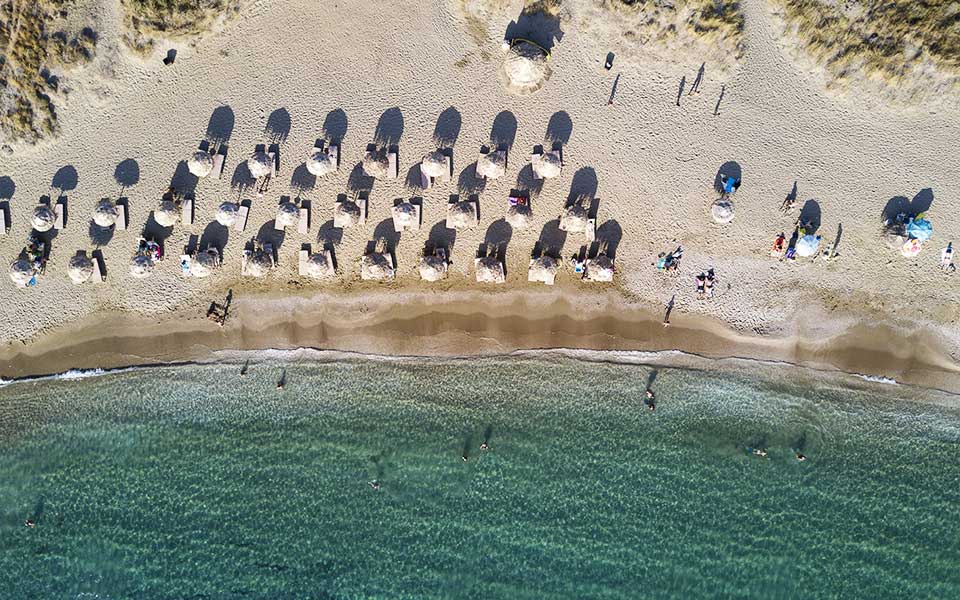With over 100 inhabited islands to choose from, it’s not that difficult to stay off the tourist-beaten path when picking a spot for your summer vacations in Greece. Whether you’re looking for a typical Cycladic island to enjoy without the hordes of tourists, a historically significant location that none of your cultured coworkers have heard of, or a remote place to spend days on the beach without the pressure of any human interaction, you’ll find it in Greece.
The only hard part is knowing where to start your search – but we’re here to help.
Here are 20 island destinations you’ll be the first of your friends to visit in 2020:
(UPDATE: Please note that the ferry / plane routes described below are for guidance only, and some details may have changed since this article was originally written).
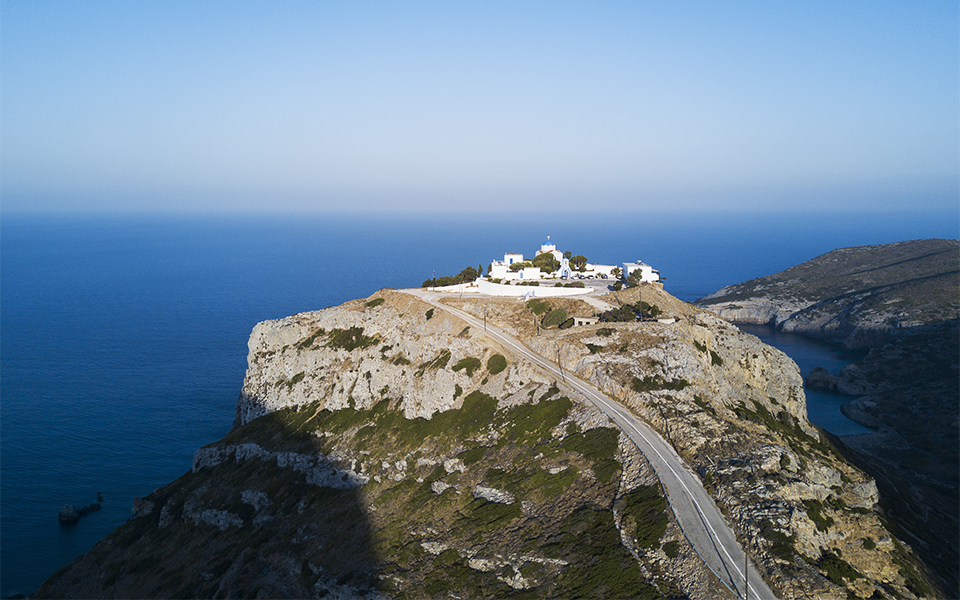
© Marika Tsouderou
Kea
Cycling to the acorn cookie farm
You don’t need to waste a day on the ferry to reach the Cyclades. Kea is located a mere hour and a half by ferry from the port of Lavrio just outside of Athens. While the island has seen a rise in visitors in recent years, thanks in part to the many accommodation options available on Airbnb, a large percent of the summer visitors are Athenians rather than foreigners, which ensures a less touristy feel. Bring (or rent) a bicycle. There’s no better way to see this island, which features 65 kilometers of cycling paths. We also recommend a visit to the Red Tractor Farm, where the acorns from the island’s indigenous oak trees are used to make flour (and acorn flour cookies!)
Read more about Kea here.
How to get there: Take a taxi (ca 30 min) from Athens International Airport to Lavrio. The ferry from there takes 1.5 hours.
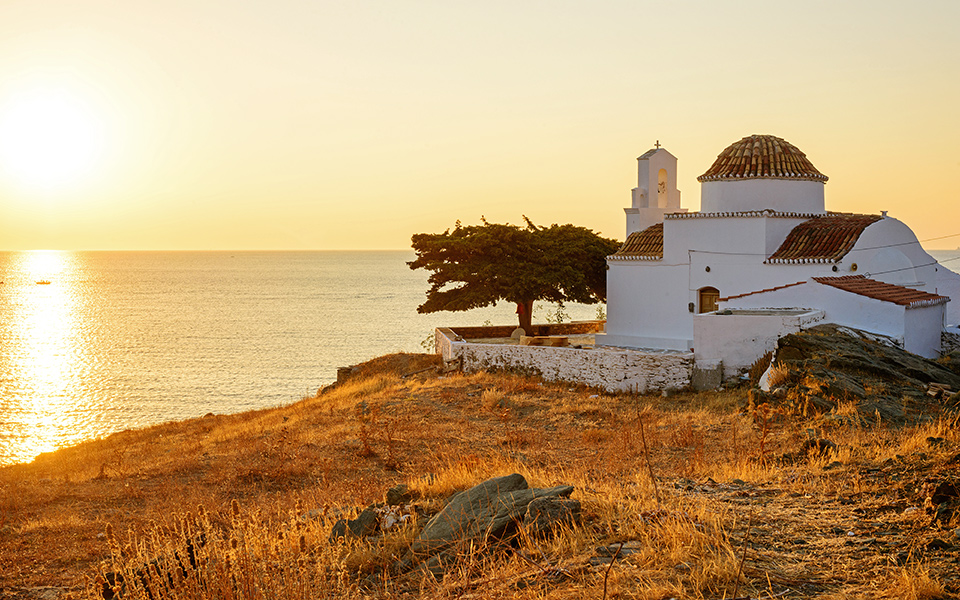
© Shutterstock
Kythnos
Shipwrecks and stalactites
Situated just below Kea and only a three-hour ferry ride from the port of Piraeus, Kythnos is similarly a relatively serene Cycladic island. Sights include the Katafyki cave with its multicolored stalactites in the village of Dryopida, the Tourkala lakes, the Panaghia church at Kanala, with its miracle-working icon, the medieval castle at Oria, and the thermal springs at the village of Loutra – once frequented by Greek royalty. You can also find the first diving center in Greece to specialize in diving for people with mobility disabilities in Dryopida (the diving spots around the island include a WWII shipwreck).
Read more about Kythnos here.
How to get there: The ferry from Piraeus takes 2-3 hours.
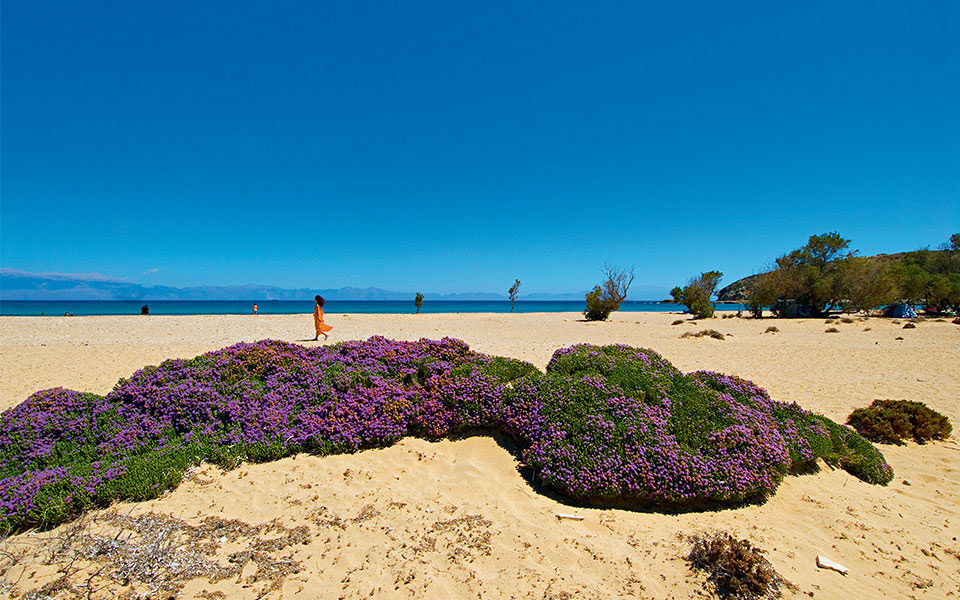
© Clairy Moustafellou
Gavdos
A place to unplug
You can hardly get somewhere more remote, and definitely no further south in Greece. Only about 50 people live in the villages on Gavdos, south of Crete year-round, so there is plenty of space to roam alone on this, almost desert-like, sand-covered island. Many come to Gavdos for the prospect of waking up to the sound of the waves on one’s own empty beach. You can live this kind of camper’s dream in the beginning of summer and in September (the most popular beaches fill with tents in August). You can also find a few hotel rooms. Sightseeing is limited to a small folklore museum (near Korfos beach), and a lighthouse (in the village of Ambelos).
Read more about Gavdos here.
How to get there: By ferry boat from Paleochora, on Crete.
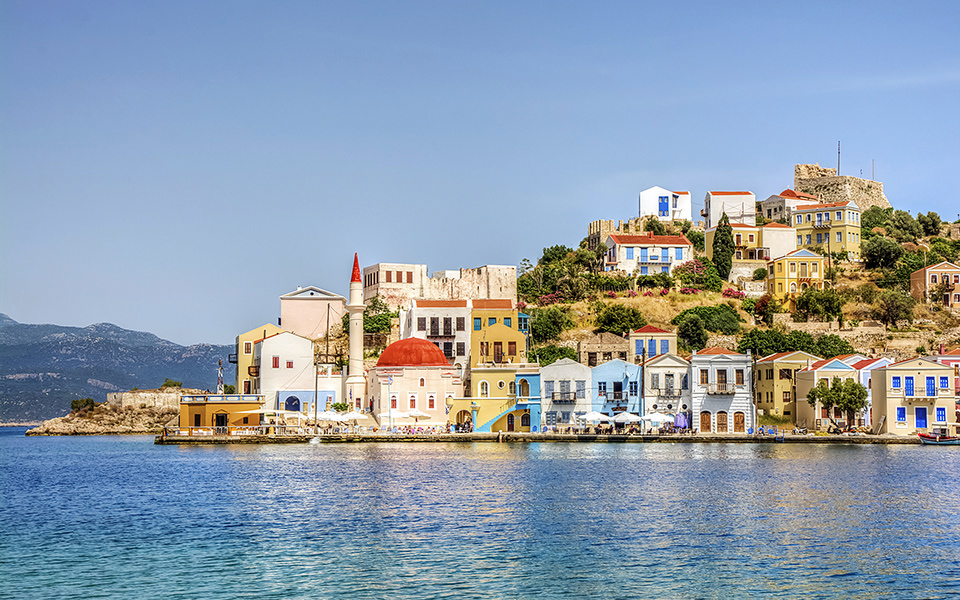
© Shutterstock
Kastelorizo
A colorful outpost near the shores of Asia Minor
Despite its small size, Kastelorizo is also known as Megisti, meaning “greatest”. It refers to the fact that it is the largest of a group of tiny islets, but the feeling of the island is, in a way, also quite grand. Located just two kilometers off the coast of Turkey, this is the easternmost island in Greece (except for the tiny islet Strogyli, which belongs to the same municipality), and you’ll notice many traces of Anatolian architecture, including an 18th century red-domed mosque and minaret, on your walks around town. It is a car-free settlement, and uniquely picturesque, with brightly colored mansions built wall-to-wall literally on the water’s edge. If you’re an artist, bring plenty of supplies and all your colors. Above the port towers looms the Castello Rosso, a 14th century castle. While there are no sandy beaches to speak of, you’ll have one of the most memorable dips of your life in the island’s famous blue cave, reachable via boat trip.
Read more about Kastelorizo here.
How to get there: By plane via Athens, Rhodes or Hania on Crete, or by ferry boat from Rhodes (ca 4 hours).
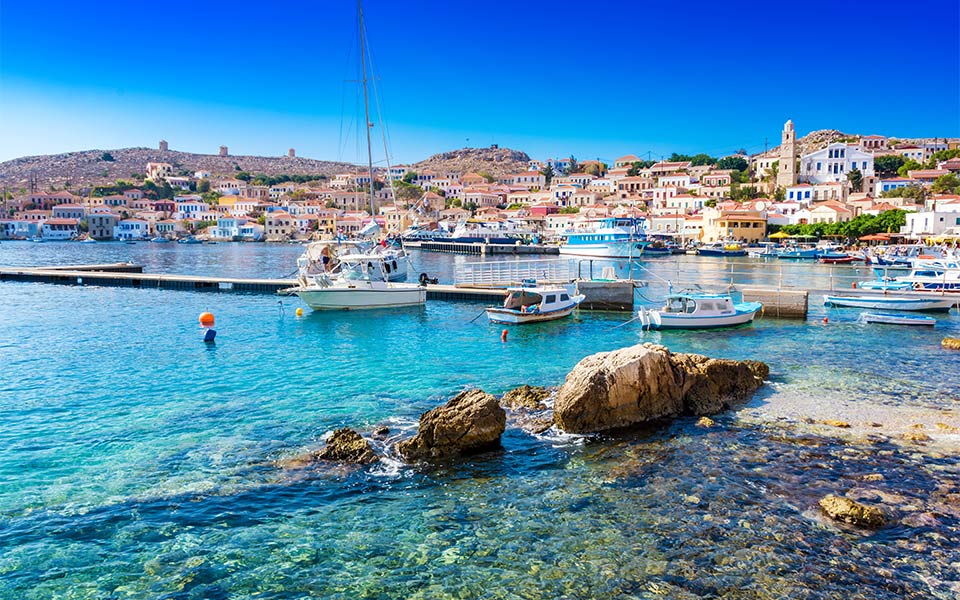
© Shutterstock
Halki
Simply unwind
The little village on Halki is as photogenic as can be, with colorful traditional homes with ceramic tiled roofs and Venetian mansions lining the waterfront. One of the smallest inhabited islands in the Dodecanese, Halki is home to a community of about 300 people, known to live life at a comfortable pace, and it won’t take long until you get into the same rhythm. There’s no traffic, and even the clock in the clock tower stands still here (its bell made too much noise for the locals’ liking) – a perfect reminder to slow down, turn off your phone, and just be.
Read more about Halki here.
How to get there: By boat from Rhodes. It takes about 1 hour and 15 minutes.
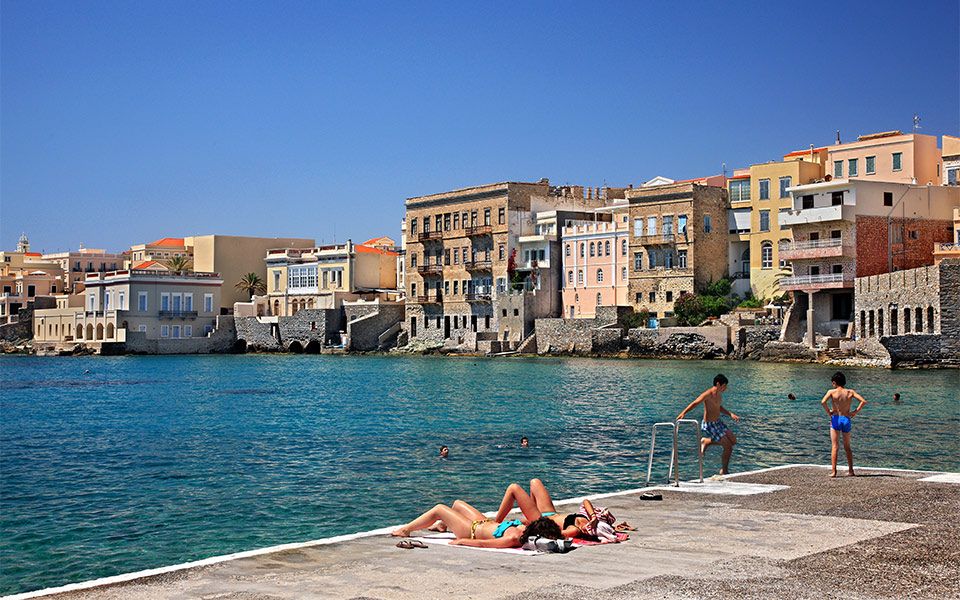
© Shutterstock
Syros
Feel like royalty
The capital of the Cyclades, Syros is pretty much self-sufficient, and therefore less dependent on tourism than many other islands. There’s a medieval village (Ano Syros), and a number of gorgeous beaches (the best ones are reached by boat), but the main attraction is the elegant main town, Ermoupolis. You can easily spend several days exploring its charming lanes, with its neoclassical buildings, impressive town hall, port district, excellent commercial center and fun nightlife. It’s not even necessary to leave town for a swim. Instead, jump into the pristine waters from the rocks below the grand mansions in the Vaporia neighborhood.
Read more about Syros here.
How to get there: The frequent ferries from the port of Piraeus take 3-3.5 hours.
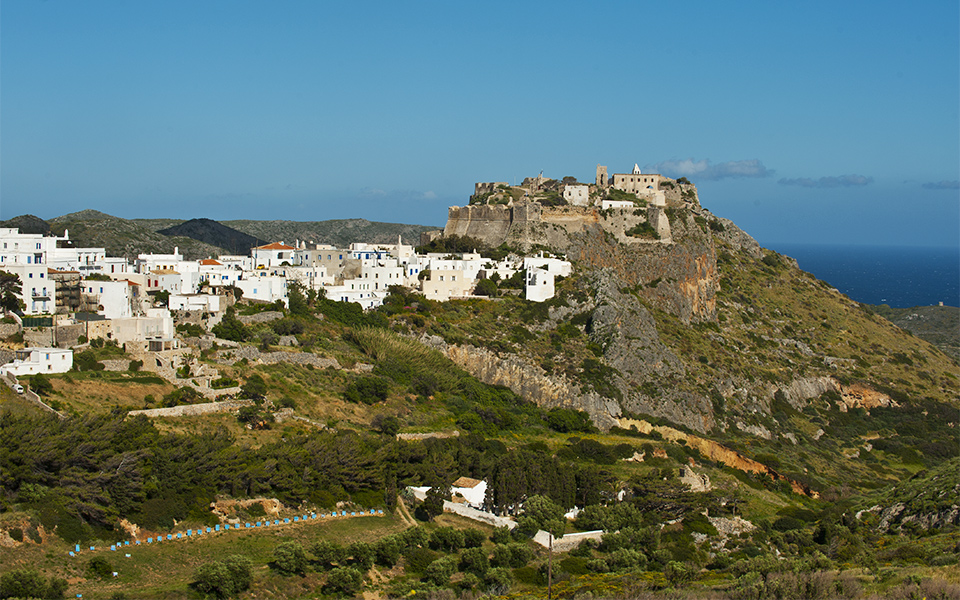
© Clairy Moustafellou
Kythira
Mermaids and fairies unite!
You need a car on this green island, and driving most of the way is also a great way to get here (you’ll see a lot of the Peloponnese on the way to Neapoli, from where you can catch a 75-minute ferry). Drive to a different beach every day; you won’t want to get out of the crystal-clear water. We like Kaladi with plenty of rocks to climb and jump off of, Kalami for a bit of adrenaline (you need to climb down a rope to get there), Fyri Ammos at Kalamos with its red sand, and Fournoi for chilling in a hammock above the water. Spending an afternoon bathing in the pool beneath the Fairy Waterfall near Mylopotamos is another unforgettable experience, and if the wind allows, so is a visit to the Hytra cave. Hikers will love it as well; two of the island’s trails recently became the first in Europe to receive Green Flag Trails certifications.
Read more about Kythira here.
How to get there: The ferry from Piraeus takes 5-7 hours. You can also catch a ferry from the port of Neapoli in the Peloponnese, which takes 1 hour and 15 minutes.
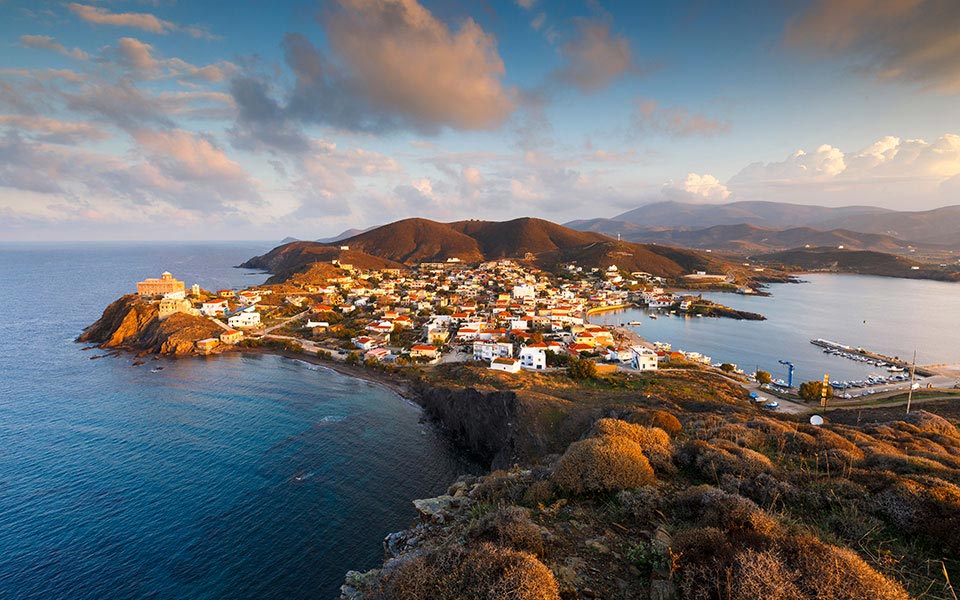
© Shutterstock
Psara
Pescetarian paradise
The name of this island is telling; it means “fishermen”, and unsurprisingly fishing is the biggest industry here. Especially famous are its lobsters – indeed in the summer visitors will make day trips from nearby Chios specifically to enjoy them. There are few permanent residents (about 450), only one village, and you can expect a relaxed vacation here. After a couple of days, you’ll feel as though you know the cobblestone alleys by heart. However, there are plenty of things to do. Pay a visit the house of Kostantinos Kanaris, hero of the war of 1821, and the memorial site at Mavri Rahi on the Paleokastro peninsula, on the western side of the harbor. Psariot warriors took their own lives in this spot in 1824, refusing capture by the Ottomans.
How to get there: Via Chios. Chios is about 45 minutes by plane from Athens and 6.5-9.5 hours by ferry boat from Piraeus.
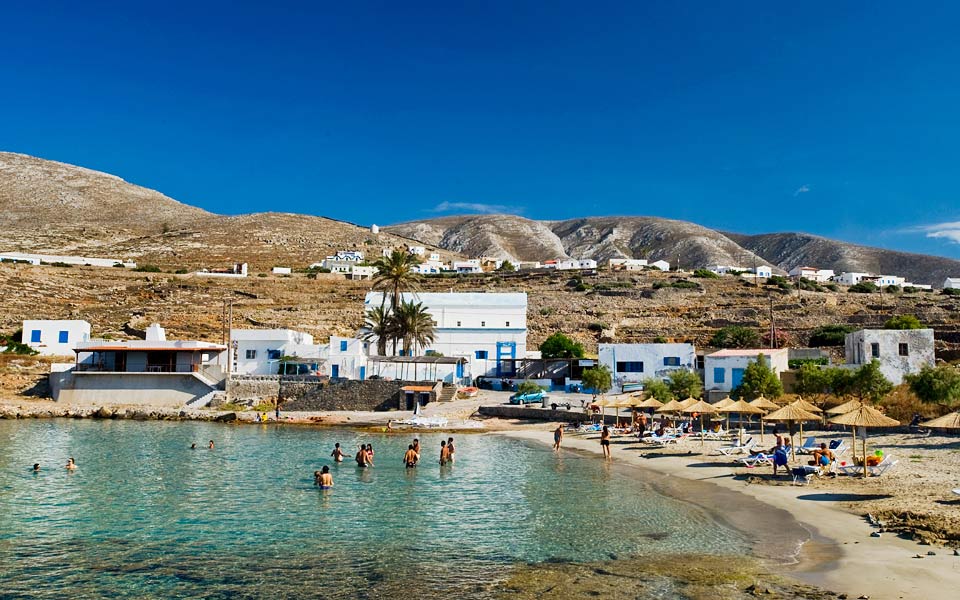
© Clairy Moustafellou
Kasos
Get into the rhythm of alenti
Kasos is known all over Greece for two things: its music and its cuisine. The pairing of the two in the tavernas and mezedopoleia during long summer evenings ensures moments that will stay in your memory forever. The music consists of the folk songs known as “mantinades”, made up of rhyming couplets – often made up on the spot – accompanied by the lyra and the laouto. They follow specific rhythmic patterns, of which there are 60 different ones. The highest regarded one is the “sacred” rhythm of alenti. Delicious foods from the Cretan-influence cuisine to try include makarounes with sitaka (the local version of mac and cheese), fakoriso (a rice and lentil dish), and dormaes (tiny stuffed grape leaves)
Read more about Kasos here.
How to get there: By ferry from Karpathos (ca 90 minutes) or from Sitia, on Crete (ca 2,5 hours).
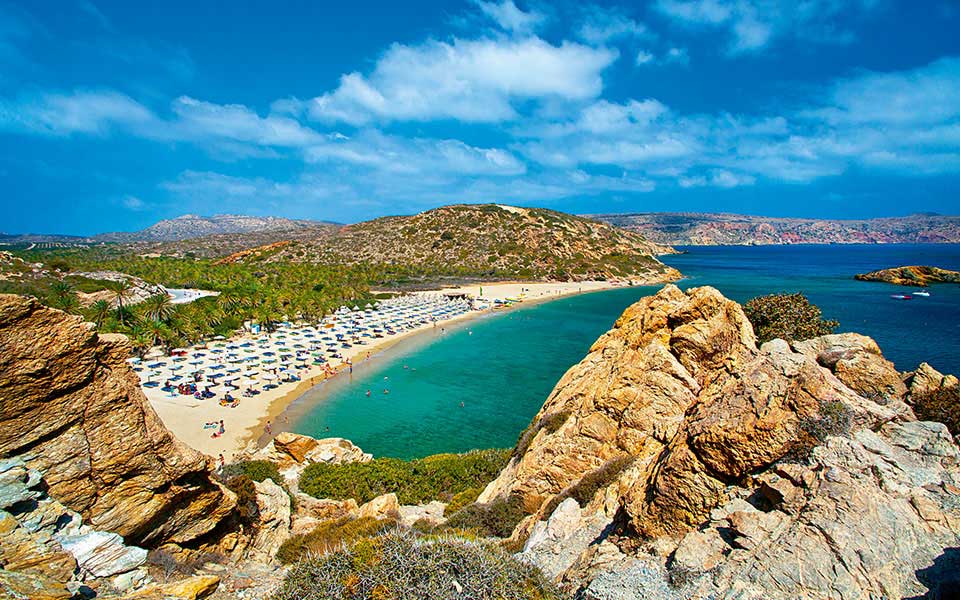
© Clairy Moustafellou
Lasithi, Crete
The secret side of Crete
While everyone knows Crete, the Lasithi region in the east of Greece’s largest island is its less frequented part. But while less famous than the regions of Hania, Rethymno and Heraklion, Lasithi has tons to offer. From the bustling city of Agios Nikolaos, the Minoan ruins at Zakros and the so-called “Gorge of the Dead”, to the tropical Vai Beach near Sitia and the relaxed surfing center at Kouremnos, there’s something for every kind of traveler in Lasithi. In Elounda, the regions most touristically developed town, you’ll find some of Greece’s most beautiful luxury resorts and spas; it’s also worth it to take a boat over to the islet of Spinalonga, especially if you’ve read Victoria Hislop’s novel “The Island”, inspired by the true story of the leper colony that once existed here.
Read more about Lasithi here.
How to get there: Travel to Heraklion by plane, or by ferry boat from the port of Piraeus (ca 9 hours), and by car (ca 50 minutes) or bus (1 hour and 50 minutes) from there to Aghios Nikolaos.
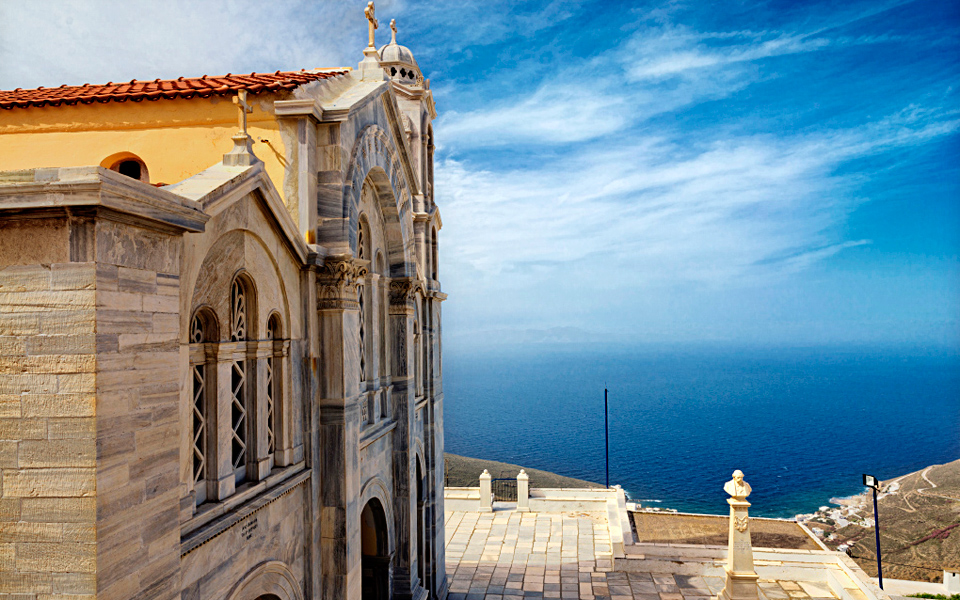
© Perikles Merakos
Tinos
Foodies in May, pilgrims in August
Awaiting you on this Cycladic island are a number of still-authentic villages, charming Venetian dovecotes, a large number of beaches and, perhaps most notably, countless churches and chapels. The Panaghia Evangelistria (Our Lady of Tinos) church, dedicated to the Virgin Mary, is home to an icon considered to be miraculous, and one of the most important religious sites in the country. Pilgrims who travel here to celebrate the Assumption of the Virgin Mary, on August 15, famously complete the last part of the pilgrimage on their knees. In the last few years, Tinos has also become a favorite spring destination with foodies, thanks to the Tinos Food Paths festival which takes place in May.
Read more about Tinos here.
How to get there: The ferry from Piraeus takes ca 5 hours. You can also catch a ferry from the port of Rafina, which takes ca 3 hours.
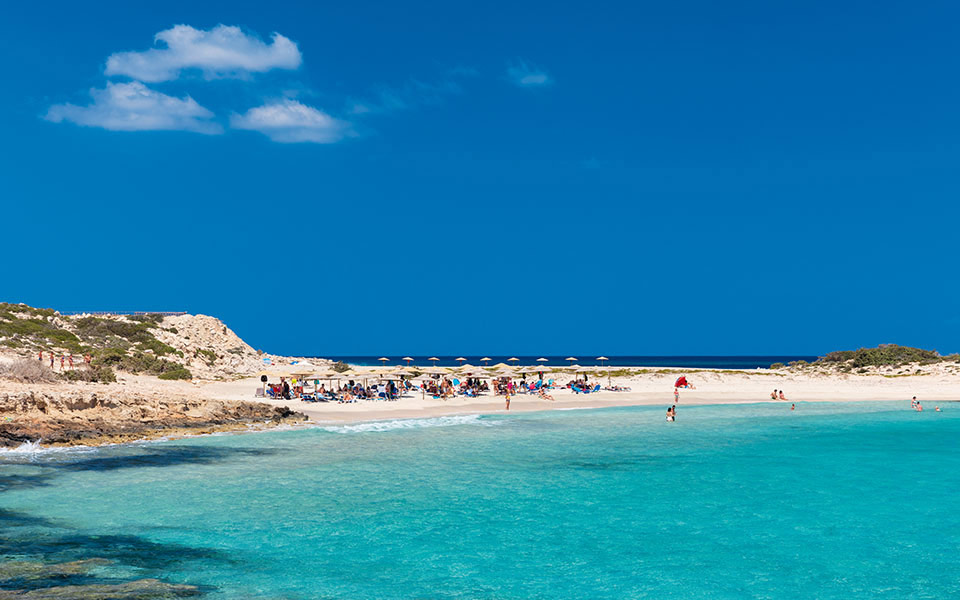
© Nicholas Mastoras
Karpathos
Natural wonders and time capsules
If you have seen photos of Karpathos on Instagram, you will have seen some of its picturesque villages. The mountain village of Olympos is the most famous of them all, known to resemble a different era, as if enclosed in a time capsule; many come here to see the residents working on their looms, or crafting ceramics and shoes. Also worth visiting are the villages of Aperi, Mesochori, and Menetes. This Dodecanese island is also a dream destination for the outdoorsy, featuring beautiful hiking trails, great windsurfing conditions, amazing underwater landscapes to discover while scuba diving, more than a hundred stunning beaches and even more rock climbing sites.
Read more about Karpathos here.
How to get there: By plane (direct or via Athens or Rhodes) or by ferry from Piraeus (18-20 hours), or from Crete.
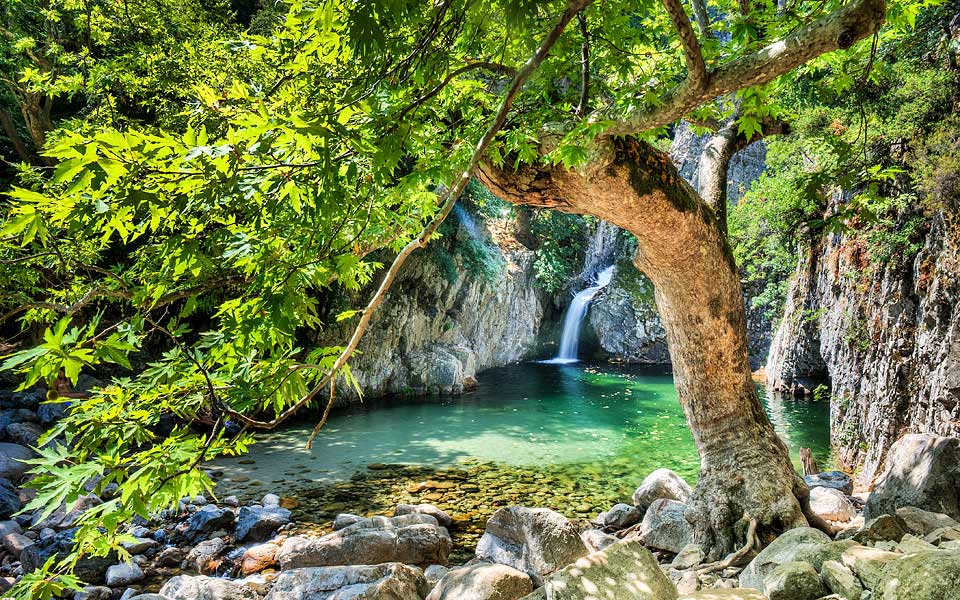
© Shutterstock
Samothraki
Lush mountain landscapes
The green island of Samothraki (Samothrace) is a popular destination among Greece’s nature lovers, thanks to its beautiful trails and lush interior. Characterized as much by its steep mountain peaks as its coastline, you’re as likely to be cooling of in a plunge pool beneath a waterfall here as at the beach. Even the main village, Chora, is built on the steep inland slopes of the island’s tallest mountain, Mount Feggari, so come prepared for some hill walking.
Read more about Samothraki here.
How to get there: By ferry from the northern Greek port of Alexandroupoli (1 hour and 50 minutes).
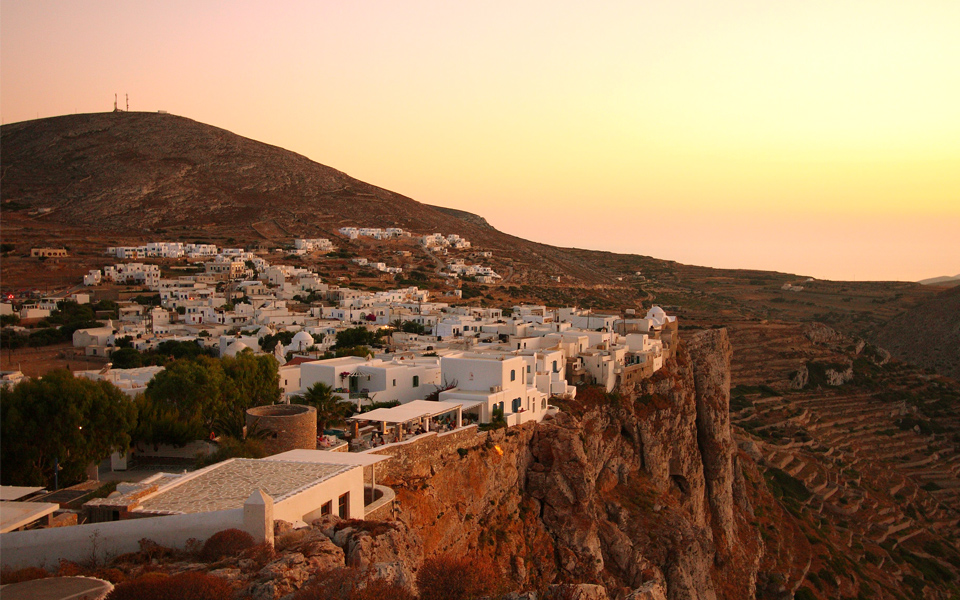
© Clairy Moustafellou
Folegandros
Classic Cyclades
Surrounded by the more famous Cycladic islands of Santorini, Milos, Ios and Paros, the smaller Folegandros features all of the classic features of the island group that we love, but has yet to be discovered by many foreign tourists. Here, you’ll discover villages of whitewashed houses with blue shutters and incredible sunsets, all without the annoying chatter of hordes of tourists on the same path, making it a perfect destination for lovebirds. The island also features a decent network of hiking and trekking paths.
Read more about Folegandros here.
How to get there: The fast boat from Piraeus takes 4-5 hours, or catch a ferry from Santorini, which takes less than 2 hours.
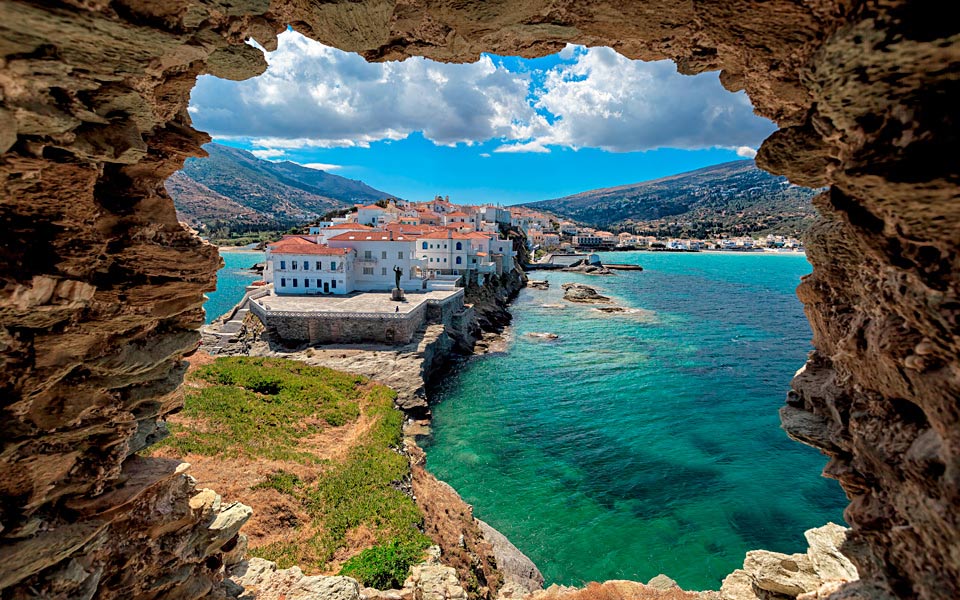
© Shutterstock
Andros
White, blue and… green.
The second largest island in the Cyclades looks quite different from the rest of them; instead of the dry and rocky hills that usually make up the backdrop for the sugar cube-like houses, here the landscape is surprisingly green, thanks to natural springs. Driving around the island to reach its sandy beaches, stop for hikes through the forests, cut through by creeks and waterfalls. In the island’s capital, Chora, you’ll find interesting museums, the remains of a Venetian castle, and the iconic Tourlitis lighthouse, built on a rock tower in the sea.
Read more about Andros here.
How to get there: By ferry boat from the port of Rafina outside of Athens. The ferry ride takes ca 2 hours.
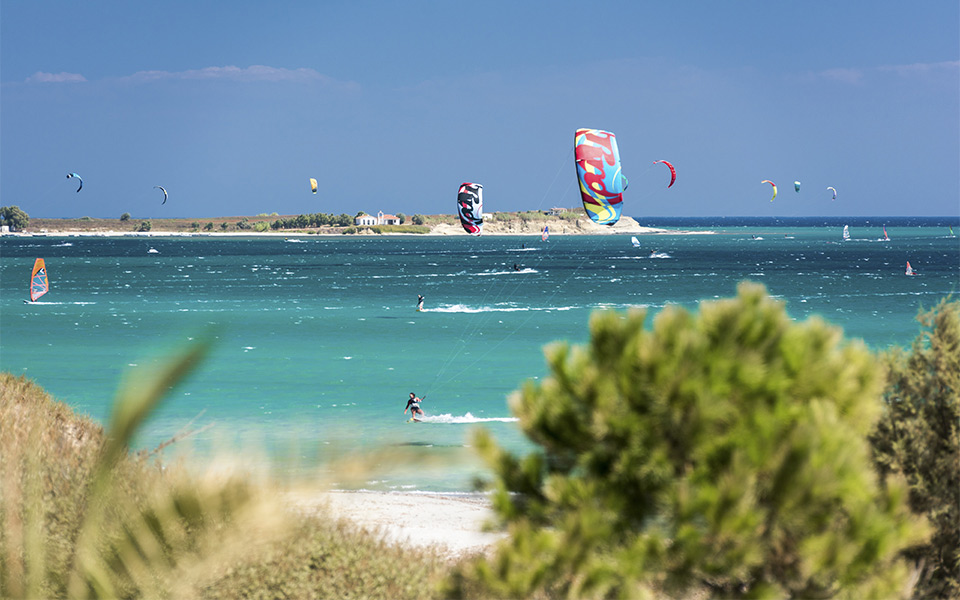
Limnos
Brave surfers. Petrified trees.
If you’re into nature (hiking, surfing, sandboarding, bathing in waterfalls and thermal springs) or learning about ancient history, Limnos will make you happy. Surfers will find friends at Keros Bay, where the surf club also runs a beautiful glamping site. History buffs can visit what is thought to be the remains of the world’s oldest parliament building, and site of the mighty city of Hephaestia. Nature and archaeology even unite to form one incredible site on Limnos: the petrified forest near Moundros. The island’s capital, the historic town of Myrina, sits below a Venetian castle, and features plenty of stores, restaurants and cafés.
Read more about Limnos here.
How to get there: You can fly from Athens International Airport or take the ferry from Piraeus, Rafina (8+ hours) or from the northern city of Kavala (about 4 hours).
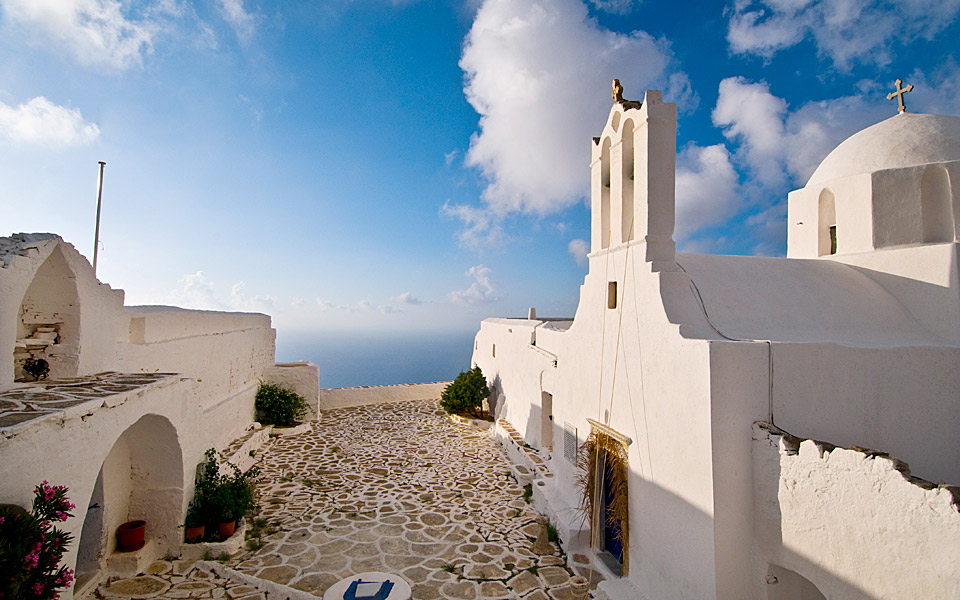
© Shutterstock
Sikinos
Cycladic island. No fuss.
You’re in the Cyclades, but with this little tourism, you can hardly tell. The main town, Chora, is built in and below a 15th c. fortress, known as Kastro. The residents of Chora live mainly in the century-old houses within the walls. You’ll also find a few shops and eateries here. Those interested in touring religious sites will be impressed with the range, from the typical tiny white churches to the 17th c. Chrysopigi monastery, featuring secret passages, battlements and murder-holes, and the Episkopi church, which was converted from a former Roman mausoleum. We recommend spending most of your days hiking to the beautiful beaches, and experiencing the beautiful serenity.
Read more about Sikinos here.
How to get there: The ferry from Piraeus takes 5-10 hours.
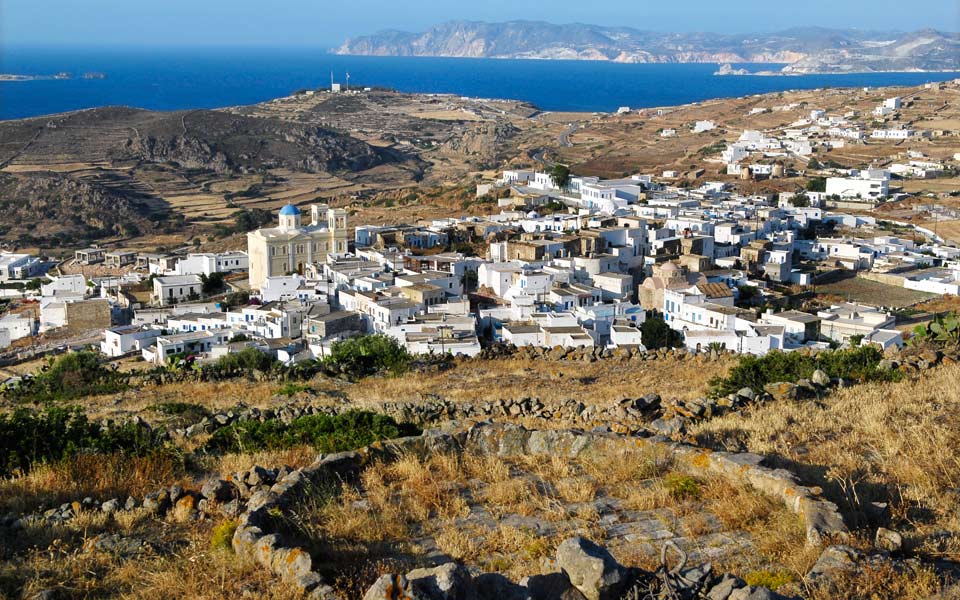
© Vangelis Zavos
Kimolos
Milos’ little sister
With tons to experience in relation to its size, Kimolos promises the perfect combination of authenticity and excitement; it’s a place where you can relax, but you won’t be bored. Visit the Gerakia and Pelekiti caves, and the Agioklimato hot springs, or hire a sea taxi to reach hidden beaches and the nearby island of Polyaigios. Or combine a hike from the main settlement, Chorio, with a swim at Skiadi or Mavrospilia, where you may spot some wild seals. The human population of about 400 permanent resident, most of whom are in Chorio, are known to organize plenty of events during the summer, so ask around to see if you can join a trek, enjoy an open-air cinema night on the beach or in a village, or anything else they have planned.
Read more about Kimolos here.
How to get there: The ferry from Piraeus takes 8,5 hours and the hydrofoil takes 5 hours. You can also catch a boat from Milos, which takes 15 min.
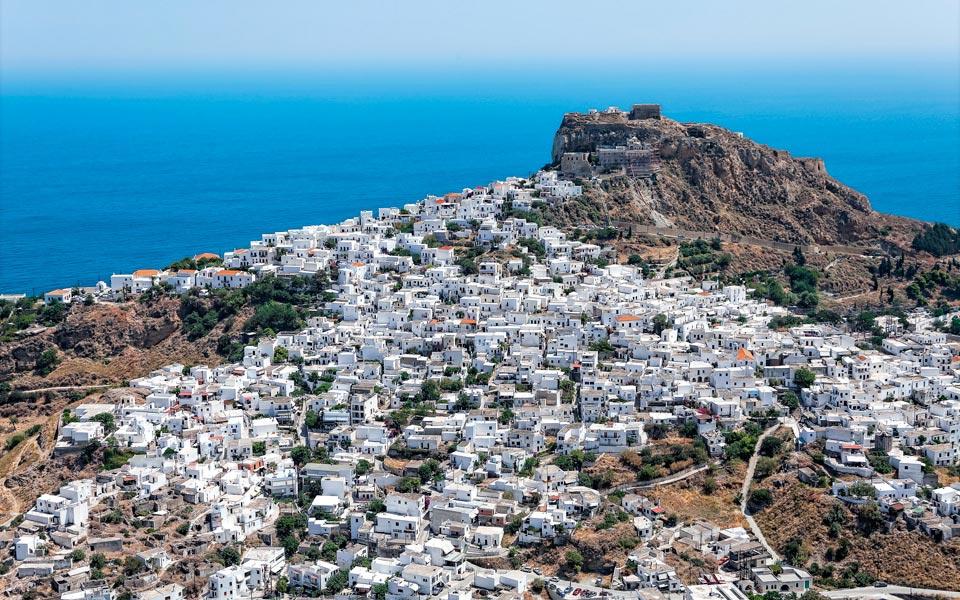
Skyros
Rare falcons and miniature horses
Located in the northern Sporades, an island group known for its wooded landscapes and excellent beaches, you’d think Skyros would overflow with tourists in the summer. On the contrary, much of the island’s charm remains a secret, which might be a good thing, because it’s also the natural habitat of two rare animals. A rare migratory falcon species settles here between the months of April and October, and the island is also home to one of the world’s oldest and rarest horse breeds, the small-sized Skyrian horse, which has survived here since antiquity. To see some of the latter, visit Mouries Farm, or head up to the strangely purple-colored Loustria Lake, on the Ari Plateau, to spot some in the wild. Skyros has plenty of history too. Above the narrow alleys and whitewashed houses of the main town, Chora, you’ll find a Byzantine castle, and the Agios Georgios monastery, dating back to 962.
Read more about Skyros here.
How to get there: By plane via Athens or Thessaloniki (ca 40 min) or by ferry boat from Kymi, on Evia island.
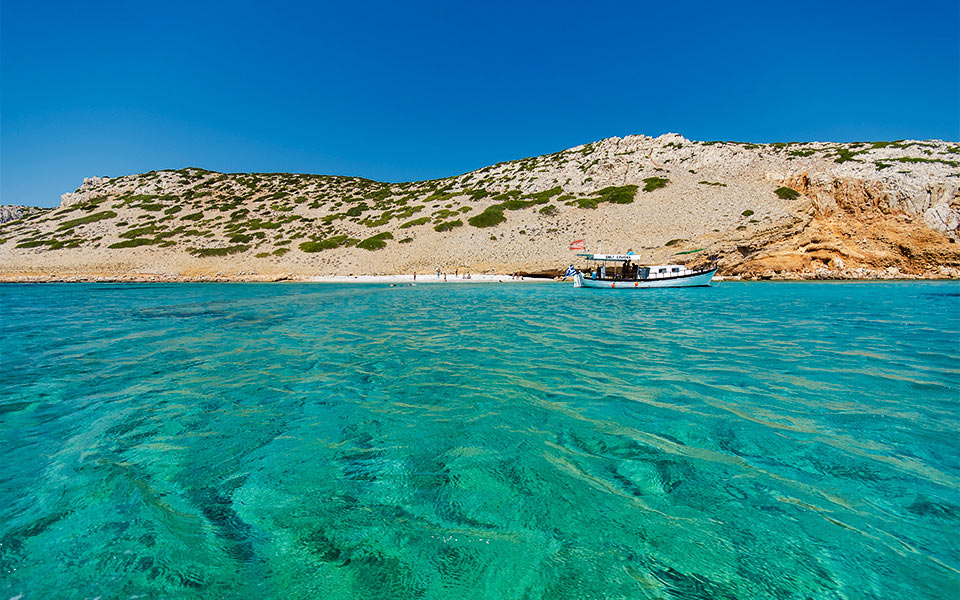
© Shutterstock
Astypalea
This butterfly-shaped island may resemble a typical Cycladic island in terms of nature and architecture, but it’s actually located in the Dodecanese. Thanks in part to foreigners having settled permanently in the main town, Chora, and to the young crowd that visits its campsite in the summer, it has a vibrant atmosphere, and some nightlife, while still maintaining an authentic village atmosphere. A must experience is a visit to the paradise-like beaches at the uninhabited islets of Kounoupa and Koutsomitis (jump on an excursion boat at Pera Gialos), a swim at the popular Kaminakia beach, with its interesting rock formations, and a hike to the serene and beautiful Ai-Yiannis beach. Another worthwhile hike is to the caves in Vathy and Vatses, which feature beautiful stalactite formations.
Read more about Astypalea here.
How to get there: By plane via Athens (ca 50 min) or by ferry boat from Piraeus (ca 9 hours).

